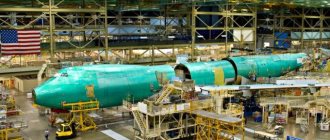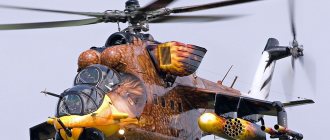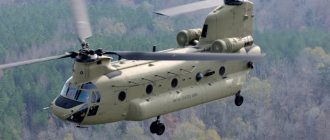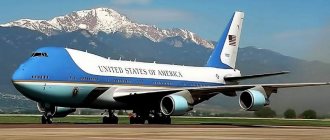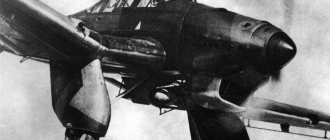The speed during landing and takeoff of an aircraft are parameters calculated individually for each aircraft. There is no standard value that all pilots must adhere to, because aircraft have different weights, dimensions, and aerodynamic characteristics. However, the value of speed when landing an aircraft is important, and failure to comply with the speed limit can result in tragedy for the crew and passengers.
How is takeoff carried out?
The aerodynamics of any airliner are determined by the configuration of the wing or wings. This configuration is the same for almost all aircraft except for small details. The lower part of the wing is always flat, the upper part is convex. Moreover, the type of aircraft does not depend on this.
The air that passes under the wing when gaining speed does not change its properties. However, the air that passes through the top of the wing at the same time becomes narrower. Consequently, less air flows through the top. This results in a pressure difference under and above the aircraft's wings. As a result, the pressure above the wing decreases, and below the wing it increases. And it is precisely thanks to the pressure difference that a lifting force is generated, which pushes the wing upward, and along with the wing, the aircraft itself. At the moment when the lifting force exceeds the weight of the airliner, the plane lifts off the ground. This happens with an increase in the speed of the liner (as the speed increases, the lift force also increases). The pilot also has the ability to control the flaps on the wing. If you lower the flaps, the lift force under the wing changes vector, and the plane sharply gains altitude.
It is interesting that the smooth horizontal flight of the airliner will be ensured if the lifting force is equal to the weight of the aircraft.
So, lift determines at what speed the plane will leave the ground and begin flight. The weight of the airliner, its aerodynamic characteristics, and the thrust force of the engines also play a role.
Airbus-A380
- Wingspan - 79.75 m
- Length - 72.75 m
- Height - 24.08 m
- Weight - 280 t
- Takeoff weight, max. — 560 t
- Number of engines - 4
- Passenger capacity, max. — 853 people
- Manufacturer - Airbus SAS Concern
Production of this aircraft began in 2005 and was put into operation in 2007. Since that time, it has officially taken first place among passenger aircraft not only in size, but also in capacity, as well as in many other parameters. For example, for aircraft of this category it is the most economical. Its fuel consumption is only 3 liters per passenger per 100 km.
Airbus-A380 aircraft
Such a huge aircraft would not be able to take off if it were built from traditional materials - it would simply be too heavy, and the lifting force of the wings would not be enough to lift it off the ground. Therefore, the main challenge for engineers and designers was the task of reducing its mass as much as possible.
Passenger compartment of the Airbus-A380 aircraft
The solution to this problem was made possible through the use of the latest composite materials, some of which were specially developed for this aircraft. For example, the central and main part of the wing (which itself weighs 11 tons!) consists of 40 percent carbon fiber. Laser technology was used to weld structural elements, which significantly increased the reliability of connections and reduced the number of fasteners.
Airbus-A380 aircraft
Among other things, the designers also took care of environmental friendliness. By reducing the amount of fuel consumed by 17% compared to the Boeing 747, they also achieved a reduction in CO2 emissions - they amount to 75 g per passenger per 1 km of travel.
Airplane speed during takeoff and landing
In order for a passenger plane to take off, the pilot needs to reach a speed that will provide the required lift. The higher the acceleration speed, the higher the lift will be. Consequently, with a high acceleration speed, the plane will take off faster than if it were moving at a low speed. However, the specific speed value is calculated for each aircraft individually, taking into account its actual weight, load level, weather conditions, runway length, etc.
To broadly generalize, the famous Boeing 737 passenger airliner takes off from the ground when its speed increases to 220 km/h. Another famous and huge Boeing 747 with a lot of weight takes off from the ground at a speed of 270 kilometers per hour. But the smaller Yak-40 airliner is capable of taking off at a speed of 180 kilometers per hour due to its low weight.
Business Class
Business class has soft, comfortable seats with a wide recline angle. The location of seats in most layout options is according to the 2-2 scheme. In total, there are from 2 to 5 rows in the bow cabin. Most often - 4 rows.
At the front of the aircraft, in front of the seats, there is a kitchen for luxury cabin clients and restrooms. The most relaxing places are the 2nd and 3rd row seats. The 1st and 4th row seats may not seem as comfortable due to the presence of nearby toilets, a kitchen and, in the case of the last row, the more crowded economy class. On some airlines, economy class is separated only by a curtain.
Types of takeoff
There are various factors that determine the speed at which an airliner takes off:
- Weather conditions (wind speed and direction, rain, snow).
- Runway length.
- Strip coating.
Depending on the conditions, takeoff can be carried out in different ways:
- Classic speed dial.
- Off the brakes.
- Takeoff using special means.
- Vertical climb.
The first method (classic) is used most often. When the airfoil is of sufficient length, the aircraft can confidently gain the required speed necessary to provide high lifting force. However, in the case where the length of the runway is limited, the aircraft may not have enough distance to reach the required speed. Therefore, he stands on the brakes for some time, and the engines gradually gain traction. When the thrust becomes high, the brakes are released, and the plane takes off sharply, quickly picking up speed. In this way, it is possible to shorten the take-off distance of the aircraft.
There is no need to talk about vertical takeoff. It is possible if special engines are available. And takeoff using special means is practiced on military aircraft carriers.
Tu-154 Speed. Dimensions. Weight. Capacity. Fuel consumption. Story
Work on the new Tu-154 passenger aircraft began at the A.N. Tupolev in 1963. The first jet passenger aircraft of this design bureau were designed on the basis of combat aircraft: Tu-104 based on Tu-16, Tu-114 based on Tu-95. In contrast, the new third-generation aircraft became the first passenger aircraft for the OKB that did not have a military prototype. At that time, three types of passenger aircraft flew on Aeroflot's medium-haul lines: Tu-104, Il-18 and An-10. This led to difficulties in ensuring the normal process of technical operation of three structurally different machines.
What is the speed of the plane when landing?
The airliner does not land on the runway immediately. First of all, the speed of the airliner decreases and the altitude decreases. First, the plane touches the runway with its landing gear wheels, then moves at high speed on the ground, and only then slows down. The moment of contact with the GDP is almost always accompanied by shaking in the cabin, which can cause anxiety among passengers. But there's nothing wrong with that.
The speed when landing an aircraft is practically only slightly lower than when taking off. A large Boeing 747 approaches the runway at an average speed of 260 kilometers per hour. This is the speed the airliner should have in the air. But, again, the specific speed value is calculated individually for all aircraft, taking into account their weight, load, and weather conditions. If the plane is very large and heavy, then the landing speed should be higher, because during landing it is also necessary to “maintain” the required lift force. Already after contact with the airfoil and when moving on the ground, the pilot can brake using the landing gear and flaps on the wings of the aircraft.
Attempts to overtake sound in passenger air travel
At the end of the 60s of the last century, the whole world learned about supersonic passenger aircraft. The first flight was made on the Soviet Tu-144. A year later, the French-English Concorde was lifted into the air. The first could fly 2300 km/h, and the second - 2150 km/h. These indicators allowed passengers to go back in time. The plane that took off from England at 9 am arrived in America at 7 am. In total, 16 Tu-144s and 20 Concordes were produced throughout history.
Due to the fact that these were very uneconomical aircraft and after a number of accidents involving them, they were withdrawn from further use in passenger air transportation. Today they are museum exhibits of the history of air travel. In the seventies of the last century, the USSR began developing a new supersonic passenger airliner, the Tu-244. But the attempt to create an ultra-fast, economical, and most importantly safe airliner is still not completed. Official data on the stage of the project is not yet known. By the way, in other countries, nothing is known yet about the success in creating this type of airliner.
Flight speed
The speed at which an airplane lands and takes off is very different from the speed at which an airplane moves at an altitude of 10 km. Most often, airplanes fly at 80% of their maximum speed. Thus, the maximum speed of the popular Airbus A380 is 1020 km/h. In fact, flight at cruising speed is 850-900 km/h. The popular Boeing 747 can fly at a speed of 988 km/h, but in fact its speed is also 850-900 km/h. As you can see, the flight speed is radically different from the speed when the plane lands.
Note that today the Boeing company is developing an airliner that will be able to reach flight speeds at high altitudes of up to 5,000 kilometers per hour.
The fastest planes
Below we will look at a number of domestic and foreign fighters.
- MiG-25 . The fighter is highly reliable and safe. It could reach speeds of up to 3 thousand km/h.
- Mig-31 . It began production in 1973 as an interceptor. Could reach up to 2500 km/h.
- Su-35 . Multi-role super-maneuverable fighter. It could reach speeds of up to 2500 km/h.
- F-22 Raptor . American fighter of the 5th generation. Reached 2570 km/h.
Today, many countries are working on new generation fighters, trying to squeeze maximum speeds out of them.
Russian hypersonic vehicles
At the moment, the Russian hypersonic aircraft is under development. But it is going quite actively. We are talking about the Yu-71 aircraft. Its first tests, judging by media reports, were carried out in February 2015 near Orenburg.
It is assumed that the aircraft will be used for military purposes. Thus, a hypersonic vehicle will be able, if necessary, to deliver destructive weapons over considerable distances, monitor the territory, and also be used as an element of attack aircraft. Some researchers believe that in 2020-2025. The Strategic Missile Forces will receive about 20 aircraft of the corresponding type.
There is information in the media that the Russian hypersonic aircraft in question will be mounted on the Sarmat ballistic missile, which is also at the design stage. Some analysts believe that the Yu-71 hypersonic vehicle being developed is nothing more than a warhead that will have to be separated from the ballistic missile at the final stage of flight and then, thanks to the high maneuverability characteristic of the aircraft, overcome missile defense systems.
Hyper-speed drones
The table shows which is the fastest aircraft flown by trained military pilots.
But the designers were able to create faster technology - models of the most powerful hyper-speed drones. They really develop such high speeds that no human body is able to withstand them. The developed speed of the fastest aircraft is 11,230 km/h (or Mach 9.2). Having become a hypersonic alternative to turbojet aircraft, these models were created exclusively for research work on testing engines created using new technologies.
Representatives:
- The Boeing X-43 aircraft is capable of flying around the entire globe in 3.5 hours. Several design associations participated in the creation of this model, and at least 1/4 billion US dollars were spent. The aircraft's hypersonic speed is achieved thanks to some features used in the design:
- A hydrogen-oxygen mixture was chosen as fuel for a supersonic engine. Moreover, only hydrogen tanks are attached to the aircraft, while oxygen is taken directly from the atmosphere. This made the car lighter. It does not pollute the atmosphere with waste;
- the product of processing is water vapor;
- performance is also ensured by the small size of the aircraft: the length is 3.6 m, and the wingspan is 1.5 m (this is a fairly light aircraft);
- A distinctive feature is the absence of rubbing parts in the design, so that the force capable of dampening the speed of the aircraft is reduced to zero.
Hyperspeed Boeing X-43
- Another 1 hyperfast aircraft is the Orbital Sciences Corporation X-34. This model is planned to have a maximum speed of 12,144 km/h (or Mach 9.9), but the aircraft was only able to reach 11,230 km/h during testing. The vehicle is accelerated by a Pegasus rocket attached to the body, powered by solid fuel. The creation of this model also took about 250 million dollars, but the entire process (from design to testing) took 7 years. The dimensions of this hyperplane are more impressive than those of the previous model: length - 17.78 m, height - 3.5 m, wingspan - 8.85 m. The vehicle's weight of 1.27 thousand kg allows it to rise no higher than 75 km, but this does not in any way prevent one from gaining sufficiently high hypersonic speeds.
- In 2010, another experimental model was created - the Falcon HTV-2, which is (supposedly) capable of transporting passengers from Australia to the UK in 1 hour. In reality, it is impossible to carry out such a flight with people on board - not a single person can withstand the enormous pressure. The machine reaches the world's highest speed of 20,291.5 km/h (or Mach 16.5), which a powerful drone can provide.
The creators plan to use the fastest aircraft in the world in situations where a rapid response to terrorist threats is necessary.
Boeing X-43
There is only one model in this category, the Boeing X-43, which is the fastest aircraft today. This drone can accelerate to 11,230 km/h. Anyone who hasn't forgotten their physics lessons can easily calculate that this is 9.6 times the speed of sound.
The project has been in development for 10 years and its goal is experimental development in the field of hypersonic aviation. Scientists and designers predict that hypersonic aircraft are the future of aviation. After all, they are able to deliver a person to any point on Earth in 3-4 hours.
https://youtube.com/watch?v=cUf9xrn6SeM%3Ffeature%3Doembed
So we met the fastest aviation record holders, but designers competing in the field of creating the fastest aircraft still should not forget about safety. Let us remind you that our site has already written about the largest.
Of course, aircraft have not yet reached their speed limit, and every year the world learns about new design developments of supersonic aircraft.
Author of the article: Valery Skiba
Tu-144
The Soviet supersonic passenger plane made its first flight on the last day of 1968, and in 1977 it began carrying out passenger transportation. The appearance of a supersonic aircraft became a challenge of the time, and for many years determined the vector of development of civil aviation.
But the history of the first Soviet supersonic airliner was short-lived. After several disasters, it was withdrawn from service in 1978. The aircraft, which reaches a speed of 2430 km/h, was used for space experiments until 1999. Today there are 5 copies preserved in the world, which are in aviation museums, as well as in storage at training airfields.
Video
https://www.youtube.com/watch?v=129-mdk8wxw
But will passengers be able to fly freely on airplanes capable of making long flights from one part of the hemisphere to another in a matter of hours? To create an ultra-high-speed passenger aircraft, large investments amounting to hundreds of millions of dollars are required.
To begin with, we will need a large investment in the development of innovative technologies that will allow us to create the transport of the future, with the help of which we could make high-speed travel without refueling for tens of thousands of kilometers. For now, some countries are content with having super-fast vehicles in their arsenal.
